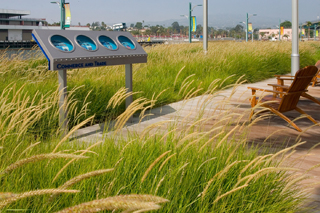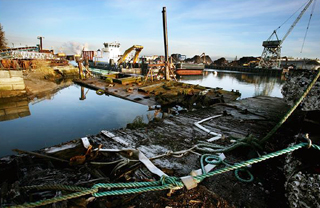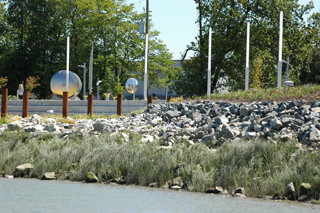|
Subscribe / Renew |
|
|
Contact Us |
|
| ► Subscribe to our Free Weekly Newsletter | |
| home | Welcome, sign in or click here to subscribe. | login |
Environment
| |
 |
September 2, 2010
Rediscovering urban waterfronts through brownfields
Aecom

Breiter
|
Industry once claimed the waterfront of most cities. Refineries, rail yards and manufacturing facilities that depended on proximity to water transportation were built on the foreground of the cityscape. This remnant of industrialization physically and visually disconnects people from the unique places that define waterfront cities.
Now these once degraded landscapes are being reclaimed. An approach called urban ecology, based on landscape and ecological systems, is helping planners to reconnect the public to the waterfront.
Increasingly, urban waterfronts are being designed in balance with natural processes to create vibrant communities that function sustainably while supporting the remaining uses of working waterfronts.
Resilient waterfronts can be rediscovered from the remains of vacant industrial land. Guided by robust environmental protection and enhancement, sustainable urban renewal, and innovative planning and design, degraded sites can become a focal point of waterfront cities, spurring economic revival and community growth.
Site remediation
With changing economies and adapting industries, many companies have moved or consolidated from waterfronts to other locations, resulting in abandoned, environmentally damaged and underused sites that are in desperate need of revitalization. Riparian, shoreline and aquatic ecosystems that once characterized the waterfront are barely recognizable, and their function is only a fraction of what it once was for the ecosystem as a whole.
These brownfield sites commonly represent significant issues to property owners and communities. Contaminated soils and groundwater, vacant buildings with asbestos and the presence of hazardous materials significantly reduce property values. Land owners are burdened with financial loss and liability, creating risk for municipalities, developers and lenders, and resulting in properties left undeveloped for decades.
The regulatory environment has evolved and support for brownfield redevelopment has significantly improved. The Environmental Protection Agency’s Brownfields Initiative and the state’s Voluntary Cleanup and Brownfield Program have enabled a viable means to re-use these properties. With careful land-use planning and appropriate redevelopment options, turning brownfields green is an increasingly safe and profitable enterprise.
Site remediation, in combination with urban and natural resource planning, can meet the most critical environmental challenges, including Superfund site mitigation, climate change adaptation and restoration of natural processes. Emerging green technologies and sustainable remediation principles are improving coordination between cleanup activities and ecosystem restoration.
From cleaning up industrial sites to managing waterfront landscapes, applied urban ecology and insightful design can shape a more positive future.
Urban regeneration
By integrating site planning and design with environmental cleanup, our most spectacular pieces of land can be successfully redeveloped. Beyond the ecological benefits, redeveloping infill sites reduces the demand to develop new sites, slows urban sprawl and allows other undeveloped sites to be preserved as habitat and open space.
Site regeneration requires more than planting native plant species; the process must be adaptively managed over time. Taking all future uses into consideration, an interdisciplinary team of scientists, economists, urban and environmental planners, and designers work best in tandem to effectively restore riparian, shoreline and aquatic habitat.
With careful consideration of both natural and built infrastructure, environmental sustainability can be designed into urban redevelopments, resulting in community revitalization through the creation of housing, tourism and job creation.
Vibrant communities
Structuring the built form around open space and natural systems rather than intervening in restored environments celebrates the health, vitality and livability of a waterfront’s community for generations to come.
At a waterfront scale, the interface between existing urban fabric, proposed development and the reestablishment of environmental networks requires a collaborative approach between design disciplines, engineers, ecologists, planners and the public. Providing opportunities for sustainable industry and commerce that support elements that make up a lively public place, such as markets and civic gathering spaces, ensures that a waterfront attracts people at all times of day and seasons.
Cities such as Richmond, B.C., and Los Angeles have already begun to integrate urban ecology and design to turn industrial waterfronts into vibrant communities.
The Los Angeles Waterfront Revitalization project repurposed industrial lands to provide public access, restore shoreline ecologies, and balance the social and economic disparities along 7 miles of waterfront. The project repurposed more than 4 acres of asphalt for open space, low-impact urban drainage and increased urban tree canopies, creating vibrant spaces amid the least socially integrated waterfront communities.
The city of Richmond proposed to redevelop industrial waterfront lands into a new urban edge along the Fraser River. Created for the 2010 Winter Games, the water’s edge was carved into more natural forms to protect the downtown from future sea level rise and provide direct public access to the water. The design also restored riverine ecologies in the lowlands and uplands.
Waterfronts are dynamic on every level and will continue to change over time. Applied urban ecology is vital to the process of waterfront industrial site regeneration. Through foresight and intentional placemaking, industrial waterfronts can be systematically transformed into adaptable and celebrated community spaces.
Newton Breiter, LEED AP, is a landscape and urban designer in the Seattle offices of Aecom Design + Planning.
Other Stories:
- Here comes a flood of stricter stormwater rules
- Treating construction site runoff with electrocoagulation
- Local engineer spends two years helping out in India
- Traveling the road to sustainability
- Washington’s e-waste law is a stewardship model
- ‘Green skins’ grow in the Emerald City
- Balancing ecosystems with economic vitality
- Tapping stormwater runoff as a resource
- What commercial lenders need to know before foreclosing
- Use LEED as a guide, not a bible





